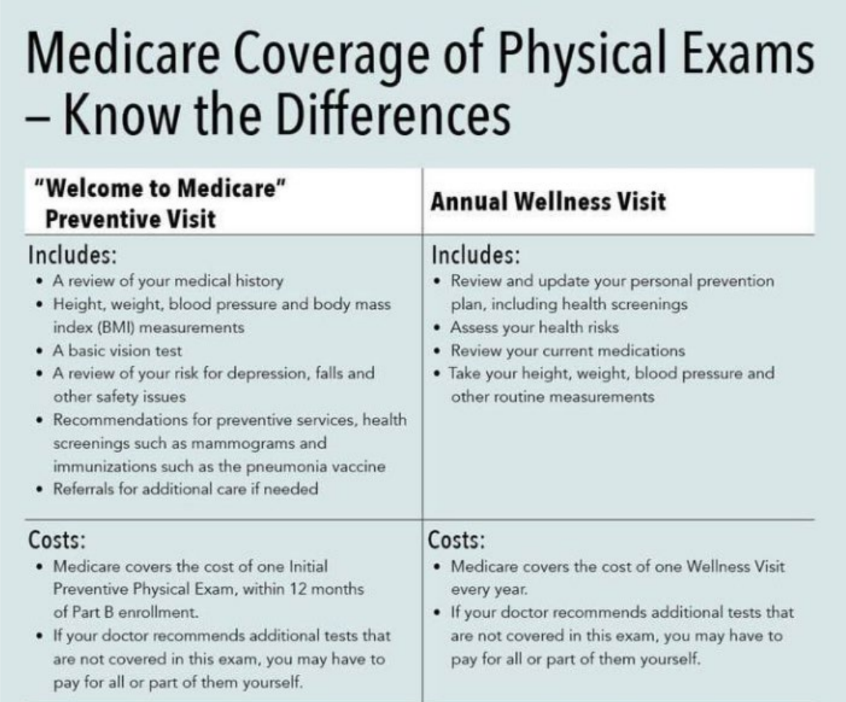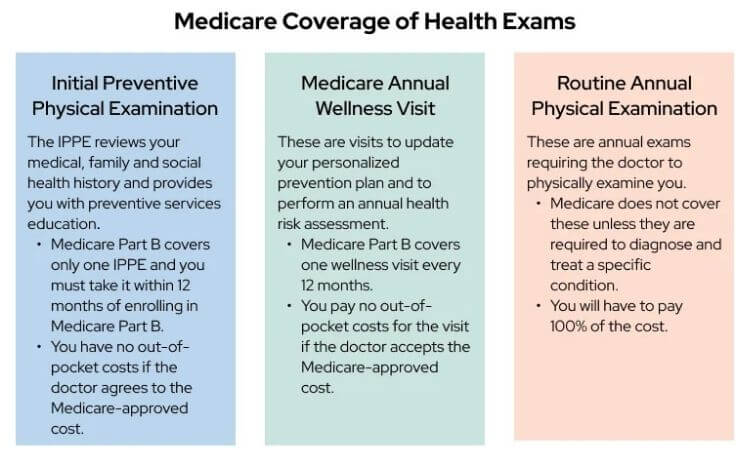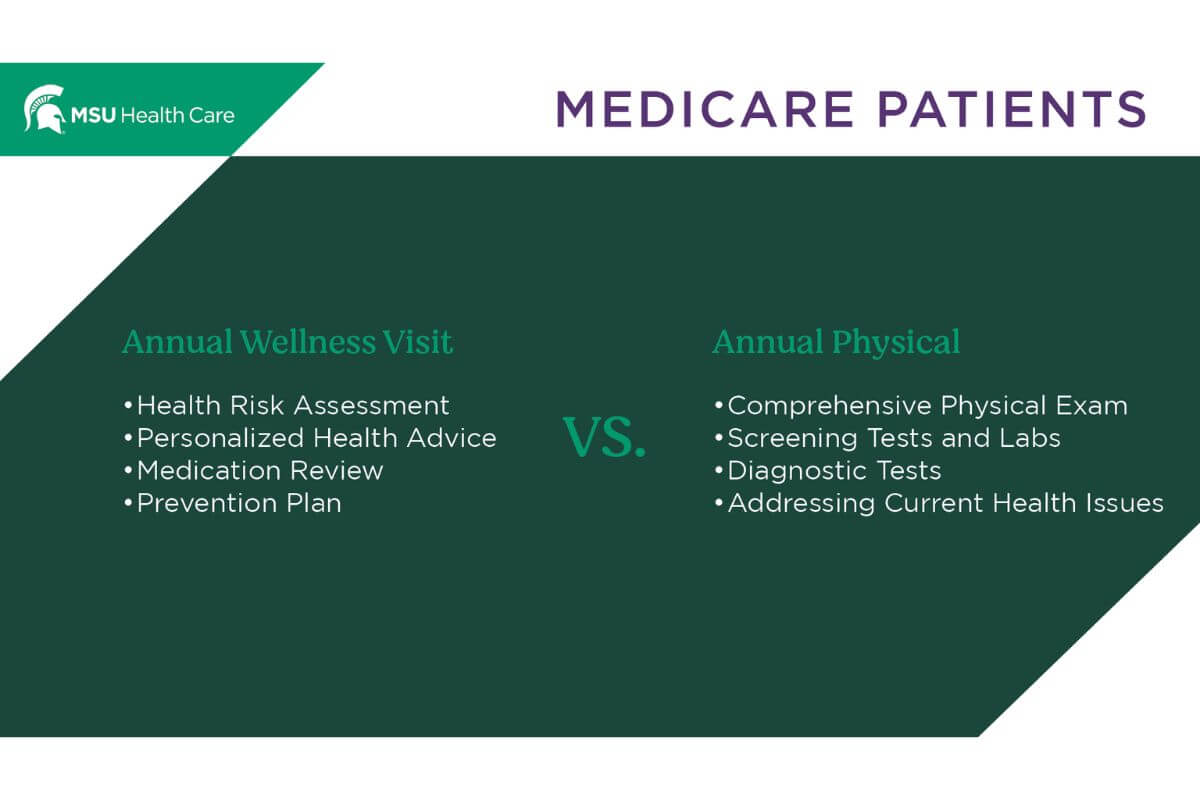Wellness vs. Physical Exams: A wellness exam focuses on preventive care and overall health, while a physical exam assesses current medical conditions. Both are essential but serve different purposes.
Wellness exams primarily aim to prevent future health issues. They include screenings, vaccinations, and lifestyle advice to maintain optimal health. Physical exams diagnose and manage existing health concerns. These exams involve a thorough review of medical history, physical assessment, and diagnostic tests.
Regular wellness exams can help catch potential problems early. Physical exams ensure ongoing medical conditions are effectively managed. Both exams contribute significantly to long-term health and well-being. Scheduling these exams regularly can lead to better health outcomes.

Credit: www.sdinsured.com
Defining Wellness Exam
Understanding the difference between a wellness exam and a physical exam is crucial for maintaining good health. A wellness exam focuses on preventive care and overall well-being. Let’s delve into what a wellness exam entails.
Focus Areas
A wellness exam primarily focuses on your overall health and lifestyle. The goal is to identify potential health issues early. Key focus areas include:
- Diet and nutrition
- Exercise and physical activity
- Mental health
- Preventive screenings
These areas help in maintaining a balanced and healthy life. The doctor will discuss your lifestyle choices and offer advice on improvements.
Typical Procedures
During a wellness exam, the doctor performs various procedures to assess your health. These typically include:
- Review of medical history
- Measurement of height, weight, and BMI
- Blood pressure check
- Cholesterol and blood sugar tests
Additional procedures may involve screening for diseases and updating vaccinations. The aim is to catch any issues before they become serious.
| Procedure | Description |
|---|---|
| Medical History Review | Discuss past health conditions and family history. |
| Height, Weight, and BMI | Measure and assess body mass index. |
| Blood Pressure Check | Monitor blood pressure levels. |
| Cholesterol and Blood Sugar Tests | Screen for cholesterol levels and diabetes. |
These procedures help in creating a comprehensive health profile. They provide a clearer picture of your overall wellness.
Defining Physical Exam
A physical exam is a routine check-up. Doctors use it to assess overall health. It helps detect any medical issues early. Regular physical exams are vital for maintaining good health.
Focus Areas
During a physical exam, doctors focus on several key areas:
- Vital Signs: Checking blood pressure, heart rate, and temperature.
- Heart and Lungs: Listening for irregular sounds.
- Abdomen: Feeling for abnormalities.
- Skin: Examining for rashes or other issues.
- Neurological: Testing reflexes and muscle strength.
Typical Procedures
Common procedures during a physical exam include:
| Procedure | Description |
|---|---|
| Blood Tests | Checking cholesterol and blood sugar levels. |
| Urine Tests | Detecting infections and other conditions. |
| Electrocardiogram (EKG) | Measuring heart activity. |
| Immunizations | Updating vaccines if needed. |
| Physical Measurements | Recording height, weight, and BMI. |
Doctors may also discuss lifestyle habits. They provide advice on diet, exercise, and other health factors.
Key Differences
Understanding the distinction between a Wellness Exam and a Physical Exam is crucial. Both are essential for maintaining health, but they serve different purposes. Let’s dive into the key differences under specific headings.
Objectives
The primary objective of a Wellness Exam is preventive care. It focuses on maintaining your overall health and well-being. During this exam, doctors aim to detect potential health issues before they become serious.
In contrast, the main objective of a Physical Exam is to evaluate your current health status. It often addresses specific concerns or symptoms you may have. Physical exams are usually more thorough in diagnosing existing health issues.
Components
| Component | Wellness Exam | Physical Exam |
|---|---|---|
| Focus | Preventive Care | Current Health Status |
| Health History | Reviewed | Reviewed |
| Vital Signs | Checked | Checked |
| Screenings | Common | Less Common |
| Lab Tests | Based on Age/Gender | Specific to Symptoms |
| Vaccinations | Updated | Not Focused |
The components of a Wellness Exam often include health screenings, vaccinations, and lab tests based on your age and gender. These exams aim to keep you healthy and catch problems early. Routine checks of vital signs, like blood pressure and heart rate, are also included.
On the other hand, a Physical Exam includes a detailed evaluation of your current health. It might involve lab tests and screenings based on specific symptoms or concerns. This exam often addresses immediate health issues rather than preventive care.
Frequency And Timing
Understanding the frequency and timing of wellness exams and physical exams is essential. These exams serve different purposes and occur at different intervals.
Wellness Exam Schedule
Wellness exams are usually conducted once a year. They focus on maintaining overall health. The doctor reviews your lifestyle, diet, and exercise habits.
- Annual check-up
- Focus on preventive care
- Discuss lifestyle choices
Physical Exam Schedule
Physical exams might not be as frequent. They are often scheduled based on age, health conditions, or specific concerns.
| Age Group | Frequency |
|---|---|
| Children | Annually |
| Adults (18-40) | Every 2-3 years |
| Adults (40+) | Annually |
Physical exams check for specific health issues. They may include blood tests, imaging, or other diagnostic tests.
Covered By Insurance
Knowing what exams are covered by insurance can save you money. Insurance coverage for wellness and physical exams varies. Let’s explore the differences.
Wellness Exam Coverage
Wellness exams are usually covered by most insurance plans. These exams focus on preventive care. They include vaccinations, screenings, and advice on healthy living. The goal is to catch health issues early.
- Annual check-ups
- Vaccinations
- Screening tests
- Health advice
Insurance often covers these services at no extra cost. It’s important to check with your provider for specific details.
Physical Exam Coverage
Physical exams are more comprehensive. They can include specific tests based on your health needs. Coverage for physical exams varies more widely.
| Service | Coverage |
|---|---|
| Blood tests | May be covered |
| EKG | Depends on insurance |
| Specialist referrals | Often requires co-pay |
Always verify with your insurance provider. Some tests may need pre-authorization.

Who Needs Which Exam
Understanding the difference between a wellness exam and a physical exam helps to know which one you need. Both exams serve different purposes and cater to various health needs. This section breaks down who benefits most from each type of exam.
Age And Gender Factors
Age and gender play a key role in determining the need for either exam.
- Children and Teens: Wellness exams are important for children and teens. These exams track growth, development, and vaccinations.
- Adults: Adults need physical exams to monitor overall health and detect early signs of illness.
- Seniors: Seniors benefit from both types of exams. Wellness exams focus on preventive care, while physical exams address chronic conditions.
- Gender-specific needs: Women may need additional screenings during wellness exams, such as mammograms and pelvic exams. Men might require prostate screenings.
Health Conditions
Existing health conditions also influence the type of exam needed.
| Condition | Recommended Exam |
|---|---|
| Chronic Diseases | Physical Exam |
| Preventive Health | Wellness Exam |
| High Blood Pressure | Physical Exam |
| Diabetes | Physical Exam |
| General Health | Wellness Exam |
Chronic diseases require regular physical exams. These exams monitor conditions like high blood pressure and diabetes.
Preventive health focuses on avoiding illness. Wellness exams are ideal for preventive measures.
In summary, choose the exam based on your age, gender, and health needs. Wellness exams are great for preventive care. Physical exams are essential for managing chronic health conditions.

Credit: centerforfamilymedicine.com
Frequently Asked Questions
What Is A Wellness Exam?
A wellness exam focuses on preventive care. It includes assessments of overall health and screenings for potential issues. The goal is to maintain health and prevent diseases.
What Is A Physical Exam?
A physical exam is a thorough check-up. It assesses your overall health and helps diagnose any current health issues. It is more comprehensive than a wellness exam.
How Often Should I Get A Wellness Exam?
You should get a wellness exam annually. This helps detect any potential health issues early and maintain overall wellness.
How Does A For Wellness vs. Physical Exams?
A wellness exam emphasizes preventive care and screenings. A physical exam includes a detailed medical history, physical checks, and diagnosing existing conditions.
Conclusion
Understanding the difference between wellness exams and physical exams is crucial for better health management. Wellness exams focus on preventive care and lifestyle improvements. Physical exams diagnose and treat existing medical issues. Knowing which one you need can enhance your overall well-being and ensure timely medical intervention.
Prioritize regular check-ups for optimal health.

“As the voice behind Radiant Glow Health, we are dedicated to being your ultimate wellness and vitality companion. Our mission is to inspire and guide you on your journey to a healthier and more vibrant life. Join us as we explore holistic health practices and empower you to radiate wellness from within.”



